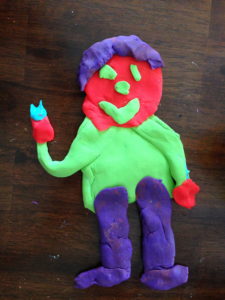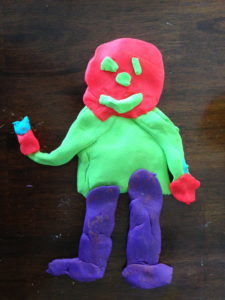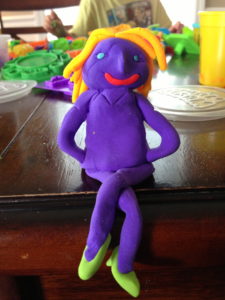Play Therapy at Home, Day 5: Play Dough
Raise your hand if you love Play Dough!!! ME!!! It is the perfect rainy day activity (yes, we are still drowning here). This time, Jack was the first to mention it so I was excited to pull it out for today’s play time.
Play therapy includes what we like to call “directive play” and “non-directive play”. Obviously, directive means that I ask the child to do specific activities (remember when I asked them to paint what they would miss after we move?). As a therapist, we have many sessions of non-directive play building the relationship and giving the child time to enjoy the room. As a parent, we have to rely on our discernment to help us know when we can be directive and when to go with the flow. Every child is different too, so some may enjoy waiting for what the directions are (Aidan) and others who may want the freedom to be creative (Jack). Both styles are equally important and both can be therapeutic. All that to say, make sure you pay attention to your child during play time and be willing to let them choose. Having control is powerful, even for us adults.
Think for a moment you are a little person. Every waking moment is determined for you.
Play time should definitely be a time for children to use their imagination any way they choose! Back to Play Dough!
The last time we played Play Dough, Jack and I had made a candy store together, so he really wanted to continue that theme. I was finishing some dinner prep so I told the boys to do whatever they wanted while I finished up. I could tell that they were catching on that each day I was going to ask them to try something specific, so I was feeling the need to have us be more non-directive play to keep the balance. My plan was to give them time to be creative and just watch how they played but have a directive option ready. Developmentally, Jack is still in a place of learning physical creativity. He is just now figuring out how to make his own creation out of LEGO’s, so asking him to do something complicated with Play Dough needed to be an option, not a challenge. Honestly, anything he decides to try and create is a huge deal. I definitely want to give him an option, but be open to him doing his own thing and celebrating that.
When I was done with my dinner prep, Aidan was especially up for the challenge. I asked them if once they were done with their current creation, if they would be willing to make themselves out of the play dough. As an extra challenge to Aidan, I asked if he would come up with a way to show me what he liked most about himself. When he got to making his face, it was funny to hear him talking to Jack about not wanting to use red, because that would make him look angry (HAHA!) I love his creation of himself.



 As they make a play dough version of themselves, pay attention to some of the details they choose to use or leave out. We will talk more about this when we get to drawing in Play Therapy. Are they leaving off hands or feet? I don’t want you to look too deeply into this- interpretations can get you into trouble, so make it a fun conversation and consider their developmental stage. Children under six years of age are likely into stick figure drawings and may not even consider hands- they haven’t even considered clothes! For example, when Aidan was done, I said, “So I noticed you don’t have any hair.” He gasped, he hadn’t even thought of that! Of course he should have hair!! (And really, how many people would go through the extra effort with play dough to make hair- well, maybe me- but that is because I didn’t want to be bald). He quickly made hair, and that was that. He put a LEGO in his “play dough-Aidan’s” hand and told me how great he was at building things. We have been talking a lot lately about engineering and he has taken a big interest in that, so I was pleased to see that he really does like that part of himself.
As they make a play dough version of themselves, pay attention to some of the details they choose to use or leave out. We will talk more about this when we get to drawing in Play Therapy. Are they leaving off hands or feet? I don’t want you to look too deeply into this- interpretations can get you into trouble, so make it a fun conversation and consider their developmental stage. Children under six years of age are likely into stick figure drawings and may not even consider hands- they haven’t even considered clothes! For example, when Aidan was done, I said, “So I noticed you don’t have any hair.” He gasped, he hadn’t even thought of that! Of course he should have hair!! (And really, how many people would go through the extra effort with play dough to make hair- well, maybe me- but that is because I didn’t want to be bald). He quickly made hair, and that was that. He put a LEGO in his “play dough-Aidan’s” hand and told me how great he was at building things. We have been talking a lot lately about engineering and he has taken a big interest in that, so I was pleased to see that he really does like that part of himself.

 At another point, I asked Jack if he would like me to make a Play Dough-Jack which would have given me an opportunity to show him how I viewed him, but he did not like that idea. That is a bit daunting for Jack to see how others might see him, but when he changed his mind later, I told him I would rather see him do one of himself someday and that I though it would not be a good idea for me to do it before he does. I purposely said this to show him that his idea of himself would be great no matter what.
At another point, I asked Jack if he would like me to make a Play Dough-Jack which would have given me an opportunity to show him how I viewed him, but he did not like that idea. That is a bit daunting for Jack to see how others might see him, but when he changed his mind later, I told him I would rather see him do one of himself someday and that I though it would not be a good idea for me to do it before he does. I purposely said this to show him that his idea of himself would be great no matter what.
Play Dough can be used in many other ways. I have a teenager that I work with that was having trouble talking to her mother about some heavy topics. After many sessions of talking (through drawing and sand) and getting her communication more comfortable we were ready to talk to mom. When I brought mom in, I was holding and playing with play dough in my hands. When it came time for the teenage girl to try talking to her mom, I offered the cool, soft, play dough to her mom to play with. I immediately noticed a difference in mom’s ability to remain calm. Several sessions later, the teenage girl told me she tried talking to her mom on another occasion at home, and beforehand gave her mom some play dough to hold on to. Now, it is a funny “cue” for them that “we are about to have a serious talk and I need you to listen.”
Play Dough can also be great for teaching anger management to children. If they are too young to make more complicated creations, you can make a ball and throw it at a target, smash and pound it on the table, make it into someone else you are angry with and smash the dough instead of using hurtful words in real life. It can also give a child a place to try using words as a “dress rehearsal” before being confronted with the real thing. For more ideas in using play dough, try here and and fun family game on expressing frustration here.
I also have this book on “101 More Favorite Play Therapy Techniques” and love this excerpt they described using play dough. To read it, click here.
